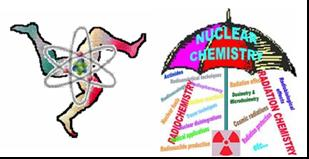Speaker
Prof.
Filippo Terrasi
(2nd University of Naples)
Description
Long lived anthropogenic alpha-emitting radionuclides have been, and stiil are, released in the environment by nuclear weapon tests, nuclear accidents, fuel reprocessing operations and nuclear power plants decommissioning. Among these the most significant are 239,240Pu and 236U. Quantification of releases and tracking their dispersion in the environment has traditionally been the task of alpha spectrometry (AS) or, more recently, of TIMS or ICP-MS. Even if these are mature methodologies, each of them has its own limitations, which are largely superseded by Accelerator Mass Spectrometry (AMS).
It is well known that in Italy no Nuclear Power Plant (NPP) is in operation, but the four dismissed NPPs are now being decommissioned; moreover, the advancement of nuclear technologies has pushed our country to reconsider its energetic policy, planning for the future the installation of new generation NPPs. Both the operations of decommisssioning of the existing NPPs and the possible future operation of new plants demand accurate investigations about the possible contamination by radioactive releases of nuclear sites and neighboring territory and of structural materials of the reactors.
The monitoring activity of surveillance institutions uses assessed radiometric techniques, but more and more ultrasensitive methodologies for the detection and quantification of ultralow activity radionuclides is requested at international level. Among these radionuclides the alfa-emitting isotopes of actinide elements are the most critical, because of their toxicity, not only radiological. The radiation counting methods, due to the long half lives, do not provide the necessary sensitivity (tipically of the order of 50 microBq) and, in some cases, resolution (e.g. 239Pu-240Pu). On the other hand, mass spectrometric techniques are potentially more sensitive than alpha counting, but suffer the problem of molecular interferences (e.g. 239Pu-238UH-208Pb31P).
In the present paper we present the state of the art of a project aiming to establish an ultrasensitive methodology for the measurement of concentrations and isotopic abundances of U and Pu at the AMS facility CIRCE, and to exploit this technique for the characterization, from the point of view of the contamination by U and Pu, of both environmental samples from the Garigliano NPP site and samples representative of the structural materials of the building and of the reactor of the same plant, at present being decommissioned.
Besides the characterization of the contamination of the site by ultralow level radionuclides, the new facility will provide a tool able to fulfill the analytical needs of IAEA for the campaigns for nuclear safeguards against illegal nuclear activities and the military use of weaponry with depleted uranium.
Primary authors
Dr
Carlo Sabbarese
(2nd University of Naples)
Ms
D'Arco Annalisa
("nd University of Naples)
Prof.
Filippo Terrasi
(2nd University of Naples)
Dr
Mario De Cesare
(2nd University of Naples)
Prof.
Vincenzo Roca
(University of Naples Federico II)
Co-authors
Dr
Alfonso Esposito
(SoGIN)
Prof.
Antonio D'Onofrio
(2nd University of Naples)
Dr
Antonio Petraglia
(2nd University of Naples)
Prof.
Nicola De Cesare
(2nd University of Naples)




